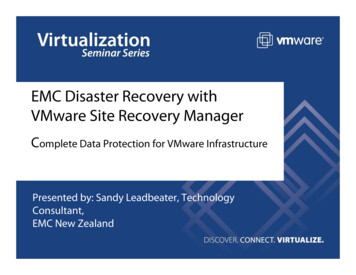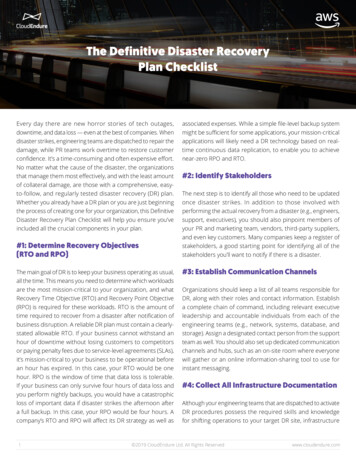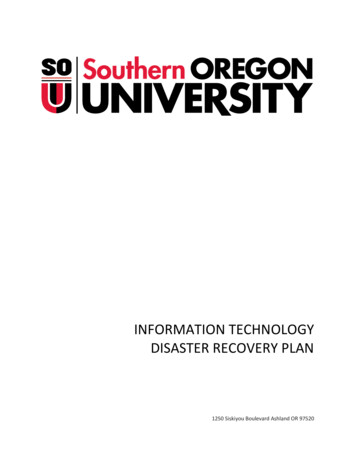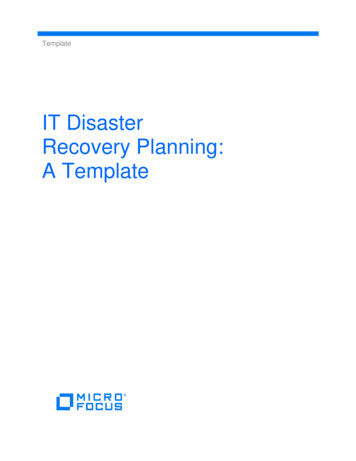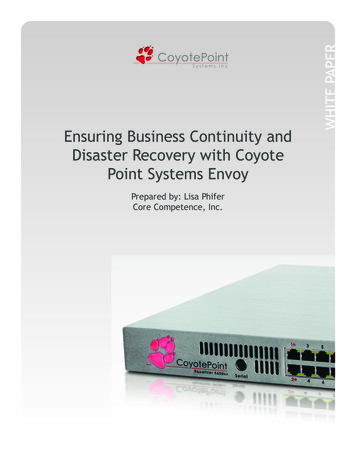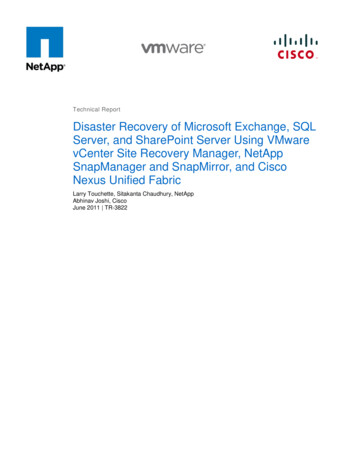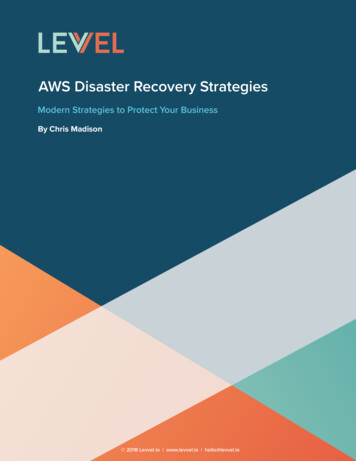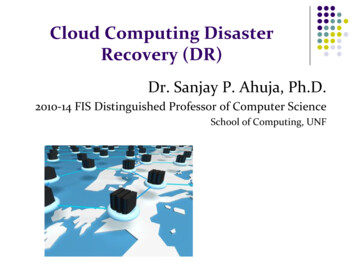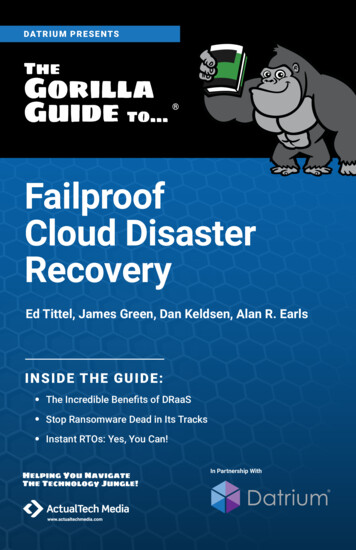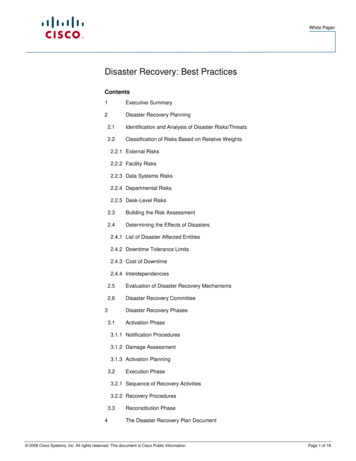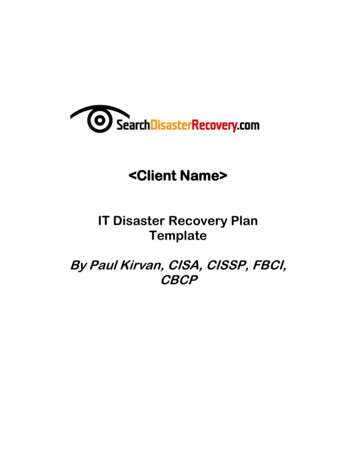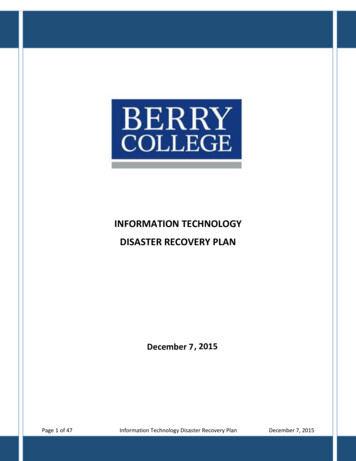
Transcription
INFORMATION TECHNOLOGYDISASTER RECOVERY PLANDecember 7 , 201531Page 1 of 47Information Technology Disaster Recovery PlanDecember 7, 2015
TABLE OF CONTENTSTABLE OF CONTENTS . 2INTRODUCTION . 5PLAN OVERVIEW . 5HISTORY . 5PLAN APPROVAL . 5DISASTER DECLARATION . 6PERSONNEL AUTHORIZED TO DECLARE A DISASTER OR RESUME NORMAL OPERATIONS . 6PLAN ACTIVATION . 6RESUMPTION OF NORMAL OPERATIONS . 6PLAN OVERVIEW, OBJECTIVES, AND DECISIONS . 7PLAN OVERVIEW . 7PLAN OBJECTIVES . 7DISASTER RECOVERY PHASES . 8Phase 1: Disaster Assessment . 8Phase 2: Disaster Recovery Activation . 8Phase 3: Alternate Site/Data Center Rebuild Phase . 8Phase 4: Return Home . 8KEY DISASTER RECOVERY ACTIVITIES . 8DISASTER DECISION TREE. 9DECISION MAKING FOR A DATA CENTER DISASTER. 10RECOVERY TIME OBJECTIVES (RTO) . 11RECOVERY POINT OBJECTIVES (RPO). 12THE DISASTER RECOVERY COORDINATOR . 13THE COMMAND CENTER & VITAL RECORDS . 13COMMAND CENTER LOCATIONS . 14PRIMARY LOCATION . 14SECONDARY LOCATION . 14VITAL RECORDS RETRIEVAL. 14Page 2 of 47Information Technology Disaster Recovery PlanDecember 7, 2015
OVERVIEW OF WHAT IS STORED OFFSITE . 14DISASTER RECOVERY TEAM . 15DISASTER RECOVERY MANAGEMENT TEAM (MGMT) . 15GENERAL RESPONSIBILITIES . 15ADMINISTRATION RESPONSIBILITIES (ADMIN) . 15PUBLIC RELATIONS RESPONSIBILITIES (PR) . 16MANAGEMENT TEAM CALL CHECKLIST . 16TECHNICAL SUPPORT TEAM (TECH) . 17HARDWARE RESPONSIBILITIES (HW) . 17SOFTWARE RESPONSIBILITIES (SW) . 18NETWORK RESPONSIBILITIES (NET). 18OPERATIONS RESPONSIBILITIES (OPS) . 19TECH SUPPORT TEAM CALL CHECKLIST . 20SEQUENTIAL LIST OF DISASTER RECOVERY TASKS . 21DISASTER ASSESSMENT PHASE . 22DISASTER RECOVERY ACTIVATION PHASE. 23ALTERNATE SITE OPERATION / DATA CENTER REBUILD PHASE . 26RETURN HOME PHASE . 27APPLICATION RECOVERY PRIORITIES . 28Tier 0 Applications (Hosted Applications - No special Disaster Recovery Plan Needed) . 28Tier 1 Applications (5 days after LAN/WAN restore) . 28Tier 2 Applications (10 days after LAN/WAN restore). 28Tier 3 Applications (15 days after LAN/WAN restore). 28Tier 4 Applications (When Possible). 28APPLICATION DETAILS . 29APPLICATION SOFTWARE PROFILE . 29SERVER RECOVERY . 30SERVER RACK LAYOUT. 30SERVER DETAILS . 30SERVER PROFILE . 30Page 3 of 47Information Technology Disaster Recovery PlanDecember 7, 2015
SERVER RECOVERY GENERAL INFORMATION . 31SERVER RECOVERY GENERAL TASK CHART . 32NETWORK RECOVERY . 33NETWORK RECOVERY PROCEDURES . 33NETWORK DIAGRAM . 33VOICE RECOVERY AT HERMANN HALL . 34PBX EQUIPMENT LISTING. 34VOICE DISASTER DECISION TREE. 34DISASTER RECOVERY PLAN MAINTENANCE . 34DISASTER RECOVERY PLAN RECOMMENDED MAINTENANCE . 35DISASTER RECOVERY PLAN UPDATE LOG . 35DISASTER RECOVERY PLAN DISTRIBUTION LIST . 36TRAINING THE DISASTER RECOVERY TEAM . 37DISASTER RECOVERY TRAINING LOG . 37TESTING THE DISASTER RECOVERY PLAN . 38SAMPLE RECOVERY TEST AGENDA . 38RECOVERY TEST HISTORY . 38DISASTER RECOVERY PLAN TESTING FORMS . 41TEST EVALUATION . 42PERSONNEL LISTING . 44DAMAGE ASSESSMENT AND SALVAGE ACTIVITIES . 44DAMAGE ASSESSMENT AND SALVAGE CHECKLIST . 44DAMAGE ASSESSMENT AND SALVAGE LOG . 46EMERGENCY TELEPHONE NUMBERS . 47Page 4 of 47Information Technology Disaster Recovery PlanDecember 7, 2015
INTRODUCTIONBerry College’s Office for Information Technology (OIT) maintains a written disaster recovery plan thatincludes all of our information resources to minimize the effects of a disaster and allow the college to eithermaintain or quickly resume mission-critical functions. This disaster recovery plan serves as the guide for BerryCollege OIT management and staff in the recovery and restoration of the information technology systemsoperated by OIT in the event that a disaster destroys all or part of those systems.PLAN OVERVIEWThe disaster recovery plan is comprised of a number of sections that document resources and procedures tobe used in the event that a disaster occurs at OIT data centers located in the Telecom Shop and/or the offsitecolocation facility. Each supported application or platform has a section containing specific recoveryprocedures. There are also sections that document the personnel that will be needed to perform therecovery tasks and an organizational structure for the recovery process. This plan will be updated on a regularbasis as changes to the computing and networking systems are made. Due to the very sensitive nature of theinformation contained in the full plan, it is confidential and not published. This is an abbreviated versionwhich can be published on the web and shared with others.HISTORYFor more than a century, Berry College has emphasized the importance of a comprehensive andbalanced education that unites a challenging academic program with opportunities for meaningful workexperience, spiritual and moral growth, and significant service to others. This commitment to providinga firsthand educational experience – expressed as “Head, Heart and Hands” by college founder MarthaBerry – remains just as relevant today as it was when the institution was founded in 1902.Nationally recognized for both quality and value, Berry is an independent, coeducational college ofapproximately 2,100 students that offers exceptional undergraduate degree programs in the sciences,humanities, arts and social sciences, as well as undergraduate and master’s level opportunities inbusiness and teacher education. Students are encouraged to enrich their academic studies throughparticipation in one of the nation’s premier on-campus work experience program, and more than 90%take advantage of this unique opportunity to gain valuable real-world experience prior to graduation.PLAN APPROVALBerry College – Mount Berry GA, Version 1.0, dated December 7, 2015 has been reviewed and approved.Penny Evans-Plants, Chief Information OfficerPage 5 of 47DateInformation Technology Disaster Recovery PlanDecember 7, 2015
DISASTER DECLARATIONPERSONNEL AUTHORIZED TO DECLARE A DISASTER OR RESUME NORMALOPERATIONSThe following employees of Berry College are authorized to declare an Information Technology SystemsDisaster and also signal a resumption of normal processing:NameTitleStephen BriggsPresidentBrian ErbVice President for FinancePenny Evans-PlantsChief Information OfficerPLAN ACTIVATIONThis plan will be activated in response to internal or external threats to the Information Technology Systemsof Berry College. Internal threats could include fire, bomb threat, loss of power or other utility or otherincidents that threaten the staff and/or the facility. External threats include events that put the facility indanger. Examples might include severe weather or a disruptive incident in the community. Once a threat hasbeen confirmed, the plan management team will assess the situation and initiate the plan if necessary.RESUMPTION OF NORMAL OPERATIONSOnce the threat has passed, equipment has been repaired or replaced, or a new data center has been builtand stocked, the disaster recovery team will assess the situation, declare the disaster over and resumenormal operations.Page 6 of 47Information Technology Disaster Recovery PlanDecember 7, 2015
PLAN OVERVIEW, OBJECTIVES, AND DECISIONSPLAN OVERVIEWThe primary focus of this document is to provide a plan to respond to a disaster that destroys or severelycripples the college's computer systems operated by the Office for Information Technology. The intent is torestore operations as quickly as possible with the latest and most up-to-date data available. This plan isdesigned to reduce the number of decisions which must be made when, and if, a disaster occurs.This plan is a “living document.” It is the responsibility of everyone involved in Berry's disaster recoveryefforts to ensure that the plan remains current. When you are aware of any changes to personnel, hardware,software, vendors or any other item documented in the plan, please bring them to the attention of the planadministrator.PLAN OBJECTIVESThe overall objectives of this plan are to protect Berry’s computing resources and employees, to safeguardthe vital records of which the Office for Information Technology is the custodian, and to guarantee thecontinued availability of essential IT services. The role of this plan is to document the procedures forresponding to a disaster that involves the data center and OIT services.A disaster is defined as the occurrence of any event that causes a significant disruption in IT capabilities. Thisplan assumes the most severe disaster, the kind that requires moving computing resources to anotherlocation. Less severe disasters are controlled at the appropriate management level as a part of the total plan.The basic approach, general assumptions, and possible sequence of events that need to be followed arestated in the plan. It outlines specific preparations prior to a disaster and emergency procedures immediatelyafter a disaster. The plan is a roadmap from disaster to recovery. Due to the nature of the disaster, the stepsoutlined may be skipped or performed in a different sequence. The general approach is to make the plan asthreat-independent as possible. This means that it should be functional regardless of what type of disasteroccurs.For the recovery process to be effective, the plan is organized around a team concept. Each team has specificduties and responsibilities once the decision is made to invoke the disaster recovery mode. The leader ofeach team and their alternates are key OIT and other college personnel. With such a small IT staff, the use ofdistinct teams with separate responsibilities is not practical as would be in larger organizations. Rather, ITstaff will be assigned to multiple teams with specific assignments made according to knowledge, experienceand availability. It is also assumed vendors and knowledgeable personnel from Berry will be actively enlistedto help during a recovery situation.Page 7 of 47Information Technology Disaster Recovery PlanDecember 7, 2015
The plan represents a dynamic process that will be kept current through updates, testing, and reviews. Asrecommendations are completed or as new areas of concern are recognized, the plan will be revised toreflect the current IT environment.DISASTER RECOVERY PHASESThe disaster recovery process consists of four phases. They are:Phase 1: Disaster AssessmentThe disaster assessment phase lasts from the inception of the disaster until it is under control and the extentof the damage can be assessed. Cooperation with local emergency services personnel is critical.Phase 2: Disaster Recovery ActivationWhen the decision is made to move primary processing to another location, this phase begins. The DisasterRecovery Management Team will assemble at the command center and call upon team members to performtheir assigned tasks. The most important function is to fully restore operations at a suitable location andresume normal functions. Once normal operations are established at the alternate location, Phase 2 iscomplete.Phase 3: Alternate Site/Data Center Rebuild PhaseThis phase involves continuing operations at the alternate location. In addition, the process of restoring theprimary site will be performed.Phase 4: Return HomeThis phase involves the reactivation of the primary data center at either the original or possibly a newlocation. The activation of this site does not have to be as rushed as the activation of the alternate recoverycenter. At the end of this phase, a thorough review of the disaster recovery process should be taken. Anydeficiencies in this plan can be corrected by updating the plan.KEY DISASTER RECOVERY ACTIVITIESDeclaring a disaster means:1.Acti
Disaster and also signal a resumption of normal processing: Name Title Stephen Briggs President Brian Erb Vice President for Finance Penny Evans-Plants Chief Information Officer PLAN ACTIVATION This plan will be activated in response to internal or external threats to the Information Technology Systems of Berry College. .
